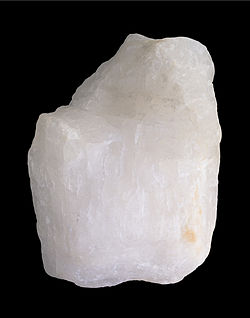On Earth
Fluorine is the thirteenth most common element in Earth's crust, comprising between 600 and 700 ppm of the crust by mass. Because of its reactivity, it is essentially only found in compounds.
Commercial sources
Three minerals exist that are industrially relevant sources of fluorine: fluorite, fluorapatite, and cryolite. [9] [10]
| Major fluorine-containing minerals | ||
 |  |  |
| Fluorite | Fluorapatite | Cryolite |
Fluorite
Fluorite (CaF2), also called fluorspar, is the main source of commercial fluorine. Fluorite is a colorful mineral associated with hydrothermal deposits. It is common and found worldwide. China supplies more than half of the world's demand and Mexico is the second-largest producer in the world.[ citation needed ]
The United States produced most of the world's fluorite in the early 20th century, but its last mine, in Illinois, shut down in 1995. Canada also exited production in the 1990s. The United Kingdom has declining fluorite mining and has been a net importer since the 1980s. [10] [11] [12] [13] [14]
Fluorapatite
Fluorapatite (Ca5(PO4)3F) is mined along with other apatites for its phosphate content and is used mostly for production of fertilizers. Most of the Earth's fluorine is bound in this mineral, but because the percentage within the mineral is low (3.5%), the fluorine is discarded as waste. Only in the United States is there significant recovery. There, the hexafluorosilicates produced as byproducts are used to supply water fluoridation. [10]
Cryolite
Cryolite (Na3AlF6) is the least abundant of the three major fluorine-containing minerals, but is a concentrated source of fluorine. It was formerly used directly in aluminium production. However, the main commercial mine, on the west coast of Greenland, closed in 1987. [10]
Minor occurrences
Several other minerals, such as the gemstone topaz, contain fluoride. Fluoride is not significant in seawater or brines, unlike the other halides, because the alkaline earth fluorides precipitate out of water. [10] Commercially insignificant quantities of organofluorines have been observed in volcanic eruptions and in geothermal springs. Their ultimate origin (from biological sources or geological formation) is unclear. [15]
The possibility of small amounts of gaseous fluorine within crystals has been debated for many years. One form of fluorite, antozonite, has a smell suggestive of fluorine when crushed. The mineral also has a dark black color, perhaps from free calcium (not bonded to fluoride). In 2012, a study reported detection of trace quantities (0.04% by weight) of diatomic fluorine in antozonite. It was suggested that radiation from small amounts of uranium within the crystals had caused the free fluorine defects. [16]